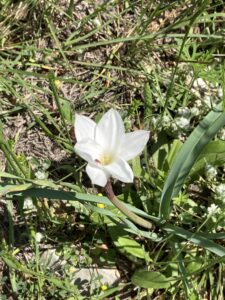by CMG Betty J
 Rain Lily, Cooperia drummondii, is a perennial wildflower that grows throughout the Texas Hill Country. Its native range extends from Louisiana to southwest Texas and south to Tamaulipas, Mexico. It is also known as the Hill Country Rain Lily, Prairie Lily
Rain Lily, Cooperia drummondii, is a perennial wildflower that grows throughout the Texas Hill Country. Its native range extends from Louisiana to southwest Texas and south to Tamaulipas, Mexico. It is also known as the Hill Country Rain Lily, Prairie Lily  and Flor de Mayo. The white flowers pop up seemingly from nowhere two or three days after it rains in April – November. Cooperia pendunculata is another variety of Rain Lily that is similar to drummondii except that it is larger in all aspects.
and Flor de Mayo. The white flowers pop up seemingly from nowhere two or three days after it rains in April – November. Cooperia pendunculata is another variety of Rain Lily that is similar to drummondii except that it is larger in all aspects.
The blooms open slowly around dusk and continue to unfurl during the night. By morning, the white, trumpet-shaped flowers are fully opened. The six petals are about two inches across and grow atop a single, unbranched 12” stem. They only last a day or two and turn to light pink as they mature.
 Flowers that are pollinated produce a seed pod at the end of the stem. The 6-12” rain lily leaves are a blueish green and grow from the base. Although their main bloom period is spring, additional blooming is often observed after a significant rain throughout the summer. An autumn rain also often produces a large bloom.
Flowers that are pollinated produce a seed pod at the end of the stem. The 6-12” rain lily leaves are a blueish green and grow from the base. Although their main bloom period is spring, additional blooming is often observed after a significant rain throughout the summer. An autumn rain also often produces a large bloom.
 Cooperia smallii, Small’s Rain Lily, is another variety of Rain Lily that grows in the Hill Country. Its physical characteristics closely resemble Cooperia drummondii except that its petals are yellow. Look for it to bloom in open grassy areas after a heavy autumn rainfall.
Cooperia smallii, Small’s Rain Lily, is another variety of Rain Lily that grows in the Hill Country. Its physical characteristics closely resemble Cooperia drummondii except that its petals are yellow. Look for it to bloom in open grassy areas after a heavy autumn rainfall.
Rain Lilies are propagated from either seeds or by dividing mature bulbs. If growing from seeds, collect the seeds a few weeks after a spring bloom and plant them soon after collecting. The seeds do not store well. The flowers grow best in a sunny location in moist clay, loam or caliche soil. If planted in a flower bed, they combine well with other plants with short foliage. When planting bulbs, plant them 8” deep to produce more flowers and 4” deep to increase bulb production. These easy-care natives can be a lovely addition to the landscape. They are seldom browsed by deer.
